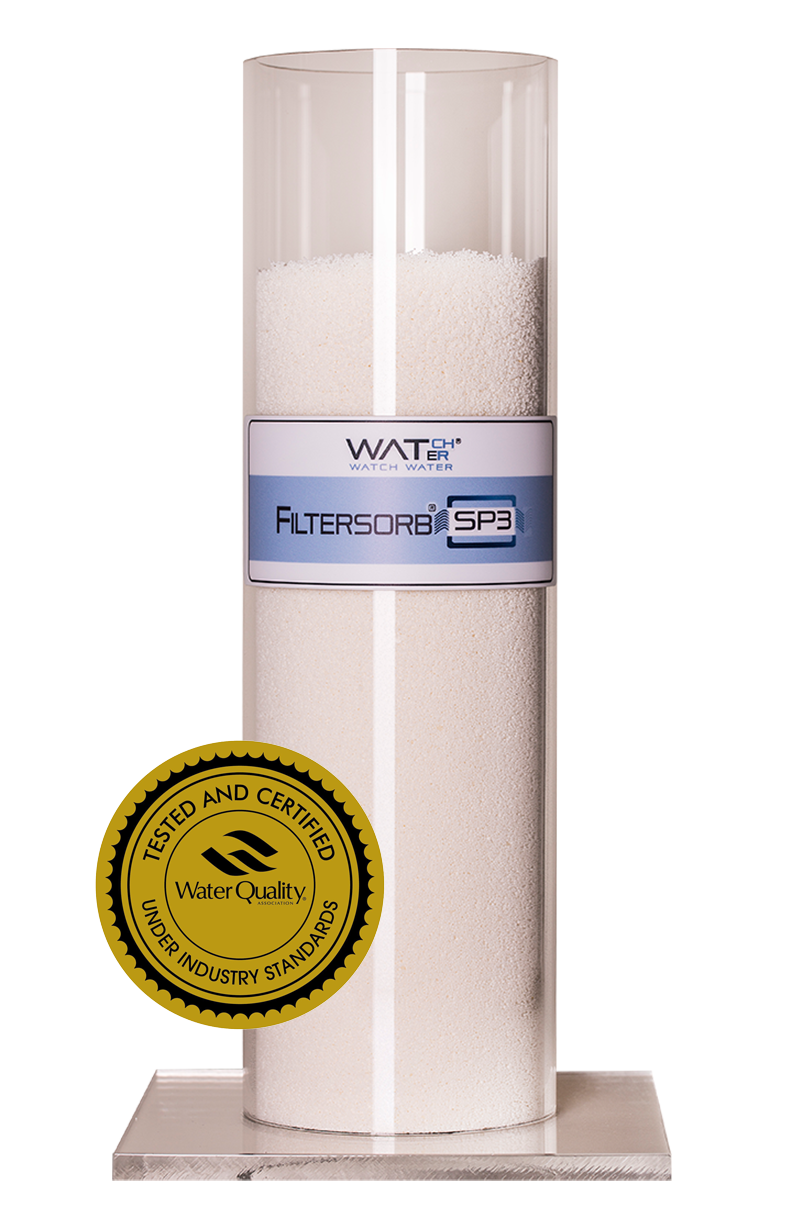Introduction
FILTERSORB® SP3 is the
result of deep research work along with its undisputable success in the market worldwide.
Watch-Water® is the embodiment of new technology called
Nucleation Assisted Crystallization (NAC).
The transformation of Calcium and Magnesium hardness into
non-soluble micro-crystals are the fundamentals of this unique product. In addition, the formed
crystals provide essential minerals to the water and making it the healthiest water available.
Above all, FILTERSORB® SP3
doesn’t add up any sodium in the water like conventional softeners.
The core motivation for developing FILTERSORB® SP3 was to find a
true replacement for the conventional sodium-based water softeners, ion-exchange resins or other
chemicals, that are either partially functional or functions at the cost of the environment and
health. Similarly, the increased sodium content in water or decreased pH factor (making the
water acidic); directly influences the health problems, environmental damage and damage to the
systems that are vulnerable to chemical corrosion due to sodium.
The recent restrictions upon many softeners eventually lead to an environmentally friendly,
cost-effectiveness and true solution for water softening.
Quick Access
Brochure Calculator
How SP3 adds tastes to your Coffee!
CO2 Made
by SP3
.

Weak ACID Cation
Problem
.

How SP3 adds tastes to your Coffee!
Media Description
Double Layered Coated (DLC) modified ceramic beads (3rd generation).
FILTERSORB® SP3 Scale Prevention method:
Based on Nucleation Assisted Crystallization (NAC). Technology, which is a directed crystallization process where continuous catalytic conversion of Carbonate water hardness into non-soluble sub-micron crystals takes place.
FILTERSORB SP3
Working Principle
When the hard water under goes nucleation in the pressure vessel, the calcium bicarbonate Ca(HCO3)2 is transformed in form of calcium carbonate CaCO3 crystals. Therefore, these crystals are formed through decomposition and crystallization process, forming very stable and harmless crystals.
The following equation describes the reaction that occurs inside the pressure vessel when flow over grains of nucleation.
• The name “SP3 (Scale Prevention)” is to indicate this unique transformation of water hardness Ca(HCO3)2 into 3 components. For instance,
1. CaCO3 (micro-crystals)
2. CO2 (colloid)
3. H2O (pure)
• In the pressure vessel, the equilibrium of carbonate species in water is shifted, assisted by the driving force of stable crystal formation. Therefore, the reaction is pushed to the right. After that, CO2 is being removed and the soluble Ca(HCO3)2 converts into insoluble calcium carbonate (CaCO3) crystals.
• As a result, calcium carbonate crystals grow steadily. However, they are very stable and cannot dissolve (incapable of forming scale) in the water.
• Glass grains crystallization sites provide increased nucleation sites for the formation of submicron sized CaCO3 crystals. Hence, this amazing process is called Nucleation Assisted Crystallization.
NAC
Nucleation Assisted Crystallization
Once formed and detached from the surface of FILTERSORB® SP3
media beads, the crystals will not adhere to any other surfaces, even in the case of hot water applications. The crystals cannot form scale because of its stable molecular structure and neutral surface electro potentiality.
Nucleation Assisted Crystallization (NAC).
The transformation of water hardness takes place in the following steps:
1. The continuous transformation of water hardness makes the immediate crystal growth possible with unidirectional chemical equilibrium viz.
Ca(HCO3)2 → CaCO3 + CO2 + H2O
As CO2 leaves fast the right hand direction of the equation is preserved.
2. The crystals developing on the surface of the FILTERSORB® SP3 bead, grow rapidly and nucleates
3. After a certain period of time the micro-emulsion of CO2 and CaCO3 forms colloid particle and leaves the media bead surface in neutral form. The average dimension of CaCO3 crystal coated globules ranges in sub micro-meter scale. The noted reaction time is normally around 5 seconds.
Micro Crystals and Colloid CO2 : The story behind amazing pH stabilization of FILTERSORB® SP3 treated water
Influence of formed CaCO3 as pH balancing factor:
The reaction: Ca(HCO3)2 → CaCO3 + CO2 + H2O is unidirectional while SP3 is transforming the hardness into water insoluble crystals.
• In nucleation assisted crystallization process formed CO2 leaves as colloid gas and is used as the template by the rapidly growing crystals in the nucleation site.
• Formed CO2 micro-bubbles exists in colloid form and thus does not form carbonic acid to dissolve back the calcium/magnesium crystals
• Hence, the reverse reaction of CO2 with water forming Carbonic Acid is not possible and the pH stability is maintained. In fact, every excess CaCO3 crystals are buffering any carbonic acid leftover. (See Illustrated Presentation)
References
Test Reference from Monarch Water
Certification
Certification for FILTERSORB® SP3
Why
FILTERSORB SP3 is The BEST ?
Some key points are mentioned here.
• No TDS change: As FILTERSORB® SP3 , does not take out or give in anything in the water. As a result of no ion-exchange chemistry, the TDS of water remains unchanged before and after the treatment.
• No pH change: pH of the water remains same. This factor makes the treated water suitable for almost any use where corrosion is concerned.
• Rich Minerals Preserved: FILTERSORB® SP3 does not add up sodium or any chemicals in the water. It simply preserves the Calcium and Magnesium contents of water, making the treated water the healthiest mineral water available. These Calcium and Magnesium are quintessential for nervous systems & muscles functionalities. They are indispensable parts in the cell chemistry of the plants and most of the life forms on earth.
• De-Scaling: Not only FILTERSORB® SP3 prevents scale formation in water channels, but it also helps to reduce the previously formed scales. The NAC process takes out water dissolved CO2 in almost-visible micro-bubbles forms that help reducing previously formed scale over a period of time (depends on the usage period).
• Biocides: NAC process creates the conditions that water dissolved CO2 agglomerate to form micro-bubbles. These CO2 bubbles actively destroys bacterial membranes acting as a biocide. So along with the scale prevention FILTERSORB® SP3 also helps preventing Biofouling.
• Test-Kit: It has the TEST KIT available, which helps one to see the performance of this unique scale prevention media within 3-4 minutes, right on the site. Watch Water has also developed a portable unit to perform live demonstrations.
Technical Data
Packaging / MSDS
| Appearance | White/opaque solid granules |
| Composition | Modified ceramic beads |
| Bulk weight (kg/m³) | 780 |
| Particle size (mm) | 0.55 – 0.75 |
| Moisture content | 10 – 25% |
| Number of Drum(s) on a pallet | Pallet Dimension (L x W x H) | Weight (volume in liters) |
| 1 | 60 cm x 40 cm x 80 cm | 50 kg (60 liters) |
| 4 | 80 cm x 60 cm x 80 cm | 200 kg (4 x 60 liters) |
| 6 | 120 cm x 80 cm x 80 cm | 300 kg (6 x 60 liters) |
| 9 | 120 cm x 120 cm x 80 cm | 450 kg (9 x 60 liters) |
| 18 | 120 cm x 120 cm x 145 cm | 900 kg (18 x 60 liters) |
Operational Parameters
& Water Impurities
| Flow direction | Up Flow |
| Recommended operating temp.(°C) | 5 to 90 |
| pH range | 6.5 to 9.5 |
| Hardness (carbonate), max. ppm | 1400 |
| Salinity, max. ppm | 35000 |
| Iron, max. ppm | 0.5* |
| Manganese, max. ppm | 0.05 |
| Free chlorine, max. ppm | 3 |
| Copper, max. ppm | 1.3 |
| Oil | Free |
| Hydrogen sulfide | Free |
Note: Do not use where water is microbiologically unsafe or with water of unknown quality without adequate disinfection before or after the unit. System must be maintained according to manufacturer’s instructions. Pre-treatment for sediment, Iron, Hydrogen Sulfide, Manganese, hydrocarbons and Copper may be required depending on conditions. Install systems in new facilities with copper pipe after six weeks of water use.
Special Information: FILTERSORB® SP3 has good capacity to absorb Iron, Copper, Manganese, Lead, Zinc etc. Therefore, in high concentration presence of these contaminants the FILTERSORB® SP3 beads may change color and come to an end of the media life. Similarly, from studies it’s also possible that the media might change color due to dye leaching from the container tank made of polyethylene.
Therefore, in case of any strange color change of the FILTERSORB® SP3 media beads or the treated water is noticed, please contact us with detailed water analysis.

 Drinking Water Treatment
Drinking Water Treatment